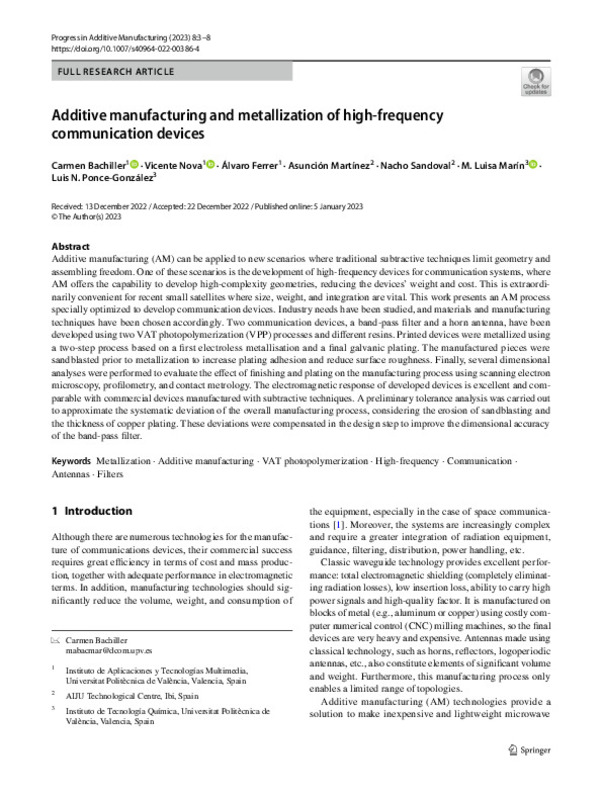JavaScript is disabled for your browser. Some features of this site may not work without it.
Buscar en RiuNet
Listar
Mi cuenta
Estadísticas
Ayuda RiuNet
Admin. UPV
Additive manufacturing and metallization of high-frequency communication devices
Mostrar el registro sencillo del ítem
Ficheros en el ítem
| dc.contributor.author | Bachiller Martin, Maria Carmen
|
es_ES |
| dc.contributor.author | Nova-Giménez, Vicente
|
es_ES |
| dc.contributor.author | Ferrer, Álvaro
|
es_ES |
| dc.contributor.author | Martínez, Asunción
|
es_ES |
| dc.contributor.author | Sandoval, Nacho
|
es_ES |
| dc.contributor.author | Marín García, Mª Luisa
|
es_ES |
| dc.contributor.author | Ponce-Gonzalez, Luis Nicolas
|
es_ES |
| dc.date.accessioned | 2024-05-02T18:08:26Z | |
| dc.date.available | 2024-05-02T18:08:26Z | |
| dc.date.issued | 2023-02 | es_ES |
| dc.identifier.issn | 2363-9512 | es_ES |
| dc.identifier.uri | http://hdl.handle.net/10251/203928 | |
| dc.description.abstract | [EN] Additive manufacturing (AM) can be applied to new scenarios where traditional subtractive techniques limit geometry and assembling freedom. One of these scenarios is the development of high-frequency devices for communication systems, where AM offers the capability to develop high-complexity geometries, reducing the devices' weight and cost. This is extraordinarily convenient for recent small satellites where size, weight, and integration are vital. This work presents an AM process specially optimized to develop communication devices. Industry needs have been studied, and materials and manufacturing techniques have been chosen accordingly. Two communication devices, a band-pass filter and a horn antenna, have been developed using two VAT photopolymerization (VPP) processes and different resins. Printed devices were metallized using a two-step process based on a first electroless metallisation and a final galvanic plating. The manufactured pieces were sandblasted prior to metallization to increase plating adhesion and reduce surface roughness. Finally, several dimensional analyses were performed to evaluate the effect of finishing and plating on the manufacturing process using scanning electron microscopy, profilometry, and contact metrology. The electromagnetic response of developed devices is excellent and comparable with commercial devices manufactured with subtractive techniques. A preliminary tolerance analysis was carried out to approximate the systematic deviation of the overall manufacturing process, considering the erosion of sandblasting and the thickness of copper plating. These deviations were compensated in the design step to improve the dimensional accuracy of the band-pass filter. | es_ES |
| dc.description.sponsorship | This work was supported by the Agencia Valenciana de la Innovación research project INNVA1/2020/84, by the Agencia Estatal de Investigación (Spain) under the Fellowship for Training PhDs BES-2017-079728, and by the Ministerio de Ciencia e Innovación (MICIN, Spanish Government) through the Research and Development projectPID2019-103982RB-C41 (under Grant MICIN/ AEI/10. 13039/501100011033). Open Access funding provided thanks to the CRUE-CSIC agreement with Springer Nature. | es_ES |
| dc.language | Inglés | es_ES |
| dc.publisher | Springer | es_ES |
| dc.relation.ispartof | Progress in Additive Manufacturing | es_ES |
| dc.rights | Reconocimiento (by) | es_ES |
| dc.subject | Metallization | es_ES |
| dc.subject | Additive manufacturing | es_ES |
| dc.subject | VAT photopolymerization | es_ES |
| dc.subject | High-frequency | es_ES |
| dc.subject | Communication | es_ES |
| dc.subject | Antennas | es_ES |
| dc.subject | Filters | es_ES |
| dc.subject.classification | TEORÍA DE LA SEÑAL Y COMUNICACIONES | es_ES |
| dc.subject.classification | QUIMICA ORGANICA | es_ES |
| dc.title | Additive manufacturing and metallization of high-frequency communication devices | es_ES |
| dc.type | Artículo | es_ES |
| dc.identifier.doi | 10.1007/s40964-022-00386-4 | es_ES |
| dc.relation.projectID | info:eu-repo/grantAgreement/AEI/Plan Estatal de Investigación Científica y Técnica y de Innovación 2017-2020/PID2019-103982RB-C41/ES/DISEÑO AVANZADO DE NUEVOS COMPONENTES DE ALTA FRECUENCIA EN TECNOLOGIAS GUIADAS COMPACTAS PARA FUTUROS SATELITES DE TELECOMUNICACION/ | es_ES |
| dc.relation.projectID | info:eu-repo/grantAgreement/AEI//BES-2017-079728//AYUDAS PARA CONTRATOS PREDOCTORALES PARA LA FORMACION DE DOCTORES 2017-NOVA GIMENEZ. PROYECTO: DEMOSTRADORES TECNOLOGICOS DE FILTROS Y MULTIPLEXORES CON RESPUESTAS SELECTIVAS Y SINTONIZABLES EN NUEVAS GUIAS COMPACTAS PARA APLICACIONES ESPACIALES./ | es_ES |
| dc.relation.projectID | info:eu-repo/grantAgreement/AGENCIA VALENCIANA DE LA INNOVACION//INNVA1%2F2020%2F84//VALORIZACIÓN DE UN MÉTODO DE FABRICACIÓN 3D, METALIZACIÓN E INTEGRACIÓN DE DISPOSITIVOS DE ALTA FRECUENCIA/ | es_ES |
| dc.rights.accessRights | Abierto | es_ES |
| dc.contributor.affiliation | Universitat Politècnica de València. Instituto Universitario de Telecomunicación y Aplicaciones Multimedia - Institut Universitari de Telecomunicacions i Aplicacions Multimèdia | es_ES |
| dc.contributor.affiliation | Universitat Politècnica de València. Escuela Técnica Superior de Ingenieros de Telecomunicación - Escola Tècnica Superior d'Enginyers de Telecomunicació | es_ES |
| dc.contributor.affiliation | Universitat Politècnica de València. Escuela Técnica Superior de Ingenieros Industriales - Escola Tècnica Superior d'Enginyers Industrials | es_ES |
| dc.description.bibliographicCitation | Bachiller Martin, MC.; Nova-Giménez, V.; Ferrer, Á.; Martínez, A.; Sandoval, N.; Marín García, ML.; Ponce-Gonzalez, LN. (2023). Additive manufacturing and metallization of high-frequency communication devices. Progress in Additive Manufacturing. 8(1):3-8. https://doi.org/10.1007/s40964-022-00386-4 | es_ES |
| dc.description.accrualMethod | S | es_ES |
| dc.relation.publisherversion | https://doi.org/10.1007/s40964-022-00386-4 | es_ES |
| dc.description.upvformatpinicio | 3 | es_ES |
| dc.description.upvformatpfin | 8 | es_ES |
| dc.type.version | info:eu-repo/semantics/publishedVersion | es_ES |
| dc.description.volume | 8 | es_ES |
| dc.description.issue | 1 | es_ES |
| dc.relation.pasarela | S\481665 | es_ES |
| dc.contributor.funder | AGENCIA ESTATAL DE INVESTIGACION | es_ES |
| dc.contributor.funder | AGENCIA VALENCIANA DE LA INNOVACION | es_ES |
| dc.subject.ods | 09.- Desarrollar infraestructuras resilientes, promover la industrialización inclusiva y sostenible, y fomentar la innovación | es_ES |
| dc.subject.ods | 12.- Garantizar las pautas de consumo y de producción sostenibles | es_ES |








